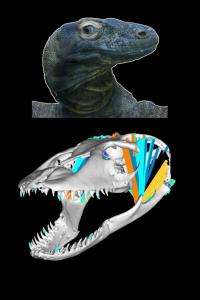Komodo dragon has 'pussycat' bite but plenty of punch

(PhysOrg.com) -- The world’s largest lizard – the Komodo Dragon – has an astonishingly weak bite, but a new study has revealed that the key to its killing power is a lethal combination of poison, brute strength, razor-sharp teeth and a “can-opener” biting technique.
Growing more than three metres long and weighing up to 100 kg, Komodo Dragons have a deserved reputation as fearsome predators and can kill animals as large as water buffalo - and occasionally humans.
Yet despite its formidable bulk, the giant reptile has a bite less powerful than that of a common house cat, says an international team of scientists - including researchers at Rutgers University (USA) and the University of New South Wales (Australia) - in a study published in the online journal PLoS ONE.
So how exactly does an animal with a pussycat bite kill a buffalo?
The researchers attached slabs of meat to strain gauges for the Dragon to ‘attack’ and showed that by harnessing the considerable strength of its limbs the lizard relies mostly on forces generated by its hefty, muscular body to employ its sharp, serrated teeth to tear away large pieces of flesh.
The findings support earlier 3D-modelling by the Computational Biomechanics Research Group at UNSW, suggesting that the big lizard’s lightweight skull was poorly adapted to resist high forces generated by jaw muscles.
“When considered together with our computer-modelling results these new data show that the Komodo Dragon operates like a giant scaly can opener,” says Dr Stephen Wroe, director of the Group. “By using its body, the animal does away with the need to invest energy in heavy muscle and bone in its head – it’s a very efficient system.”
In 2009, Wroe and other colleagues showed that the Komodo Dragon is truly poisonous, producing toxins that induce shock and promote bleeding after a bite: “People think of Komodo Dragons as ‘prehistoric’ or ‘primitive’, but the picture emerging is one of a very effective killer,” he says. “Altogether, it’s a pretty sophisticated and lethal piece of kit.”
The Komodo Dragon may be an extreme case, but the new findings also bolster the argument that forces produced by the neck and limbs may be important for other predators in prosecuting a successful kill, he notes. The team is particularly interested in understanding how carnivorous dinosaurs, many of which also had lightweight skulls, may have applied similar techniques.
More information: The paper is available online here
Provided by University of New South Wales















